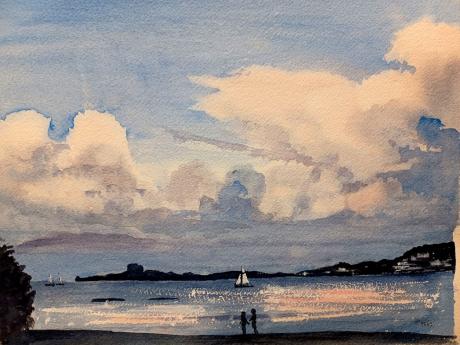" P Yates" and inscribed on the reverse
Vazon Bay is a bay in Guernsey, It is located in the northwestern part of the country, 6 km west of Saint Peter Port the country's capital.Vazon is a delightful, sandy beach on the north western coast of Guernsey. It is about a mile and a half long, making it the largest beach on the island. Get here at low tide to enjoy the vast expanse of sand. Get here early and enjoy all-day sunshine until the evening. Vazon beach also benefits from some spectacular sunsets.
Having lived with constant threats during the Seven Years' War (1754–63), threats of an invasion from France during the Anglo-French War (1778–83) resulted in additional artillery being brought to the Island and the construction of several forts, numerous batteries covering possible landing sites and fifteen Guernsey loophole towers built between 1778 and 1779,[12] The threat was real as an invasion of nearby Jersey resulted in the Battle of Jersey in Saint Helier in January 1781. Work started in 1782 on the massive Fort George, on the hill south of Town, it would take over three decades to complete. Guernsey granite was used for the majority of the gun platforms, forts and walls with embrasures often lined with brick.
A map was produced in 1787 for the Duke of Richmond as Master-General of the Ordnance to show all existing roads and military positions.
French Revolution and Napoleonic era defences
The French Revolution in 1789 added to the concerns in the Channel Islands and resulted in additional constructions and an increase in manpower.
The island militia of around 3,000 men provided both infantry and coastal artillery units. They were supplemented with regular British infantry battalions who rotated and were increased or reduced depending on the current threat to the island. Before the barracks were built in Fort George, islanders were required to provide accommodation for soldiers that could not be accommodated in Castle Cornet. Each Parish had its quota and if they were quartered in public houses or private dwellings, the parish authorities were liable for the cost.: 59 Non British units, which were not allowed on the UK mainland, were sometimes based in Guernsey, including from 1793 to 1796 French Royalists and in 1799, 6,000 Russian troops, who were quartered at Delancey.: 12 In 1796 Peter de Havilland, a Jurat was appointed superintendent of thirteen signal masts around the island, installed to give warning of approaching ships.
Lieutenant-General John Doyle was appointed Lieutenant Governor of Guernsey in 1803. After declaring a "state of emergency" in 1804, he undertook many works to improve the defence of the Island, including the draining of the Braye du Valle, improving some roads to military standard and building forts and batteries around the coast, including completing Fort George. Major-General Sir John Doyle was supported from 1810 by the new Bailiff, Peter de Havilland. The "emergency" lasted until 1815.
Doyle was instrumental in getting three Martello towers built in 1804–1805, as well as the reclaiming of Braye du Valle 1806–1808, the improved military roads with mile markers, for which he argued eloquently, against much opposition,: 48–58 and barracks which together gave the militia and regular units improved facilities to repel any invasion.
The Royal Navy provided the first line of defence, Captain Sausmarez, in command of a Guernsey-based squadron consisting of three frigates, HMS Crescent (1784), HMS Druid (1783) and HMS Eurydice (1781), a lugger, and cutter frustrated a planned invasion by 20,000 French soldiers of the Channel Islands scheduled for February 1794, due to his vigilant eye[14]: 9 Admiral James Saumarez was again put in charge of a squadron based in Guernsey from 1803 to 1808.

